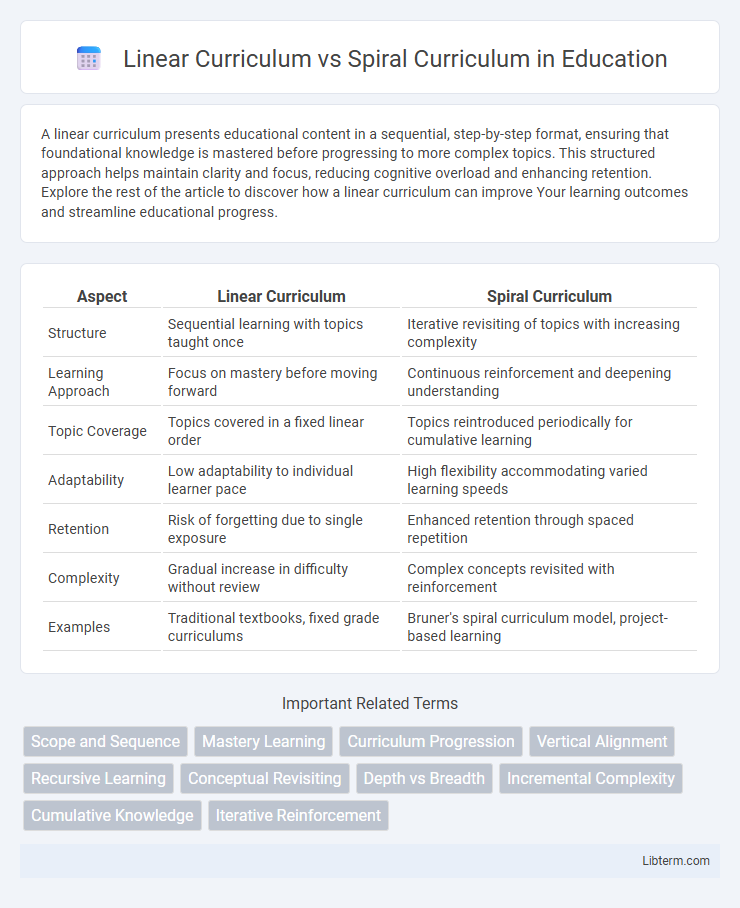A linear curriculum presents educational content in a sequential, step-by-step format, ensuring that foundational knowledge is mastered before progressing to more complex topics. This structured approach helps maintain clarity and focus, reducing cognitive overload and enhancing retention. Explore the rest of the article to discover how a linear curriculum can improve Your learning outcomes and streamline educational progress.
Table of Comparison
| Aspect | Linear Curriculum | Spiral Curriculum |
|---|---|---|
| Structure | Sequential learning with topics taught once | Iterative revisiting of topics with increasing complexity |
| Learning Approach | Focus on mastery before moving forward | Continuous reinforcement and deepening understanding |
| Topic Coverage | Topics covered in a fixed linear order | Topics reintroduced periodically for cumulative learning |
| Adaptability | Low adaptability to individual learner pace | High flexibility accommodating varied learning speeds |
| Retention | Risk of forgetting due to single exposure | Enhanced retention through spaced repetition |
| Complexity | Gradual increase in difficulty without review | Complex concepts revisited with reinforcement |
| Examples | Traditional textbooks, fixed grade curriculums | Bruner's spiral curriculum model, project-based learning |
Introduction to Curriculum Design
Linear Curriculum presents topics in a fixed, sequential order, emphasizing mastery of foundational knowledge before progressing. Spiral Curriculum revisits key concepts at increasing levels of complexity, reinforcing learning through repetition and expansion. This distinction guides curriculum designers in structuring content to balance depth and reinforcement in educational programs.
What is a Linear Curriculum?
A linear curriculum is an educational approach where learning content is organized in a sequential, step-by-step manner, with each topic building directly on the previous one. This structure emphasizes mastery of foundational concepts before progressing to more complex material, ensuring a clear, logical progression through the subject matter. It is commonly used in traditional education settings to provide a straightforward, cumulative learning experience.
What is a Spiral Curriculum?
A Spiral Curriculum revisits key concepts and skills repeatedly over time, each encounter increasing in complexity and reinforcing previous learning. This approach aligns with cognitive development theories, promoting deeper understanding and long-term retention by building on prior knowledge. Contrasting with Linear Curriculum, which presents topics in a fixed, sequential order, Spiral Curriculum allows for continual reinforcement and integration of concepts across different contexts.
Key Differences Between Linear and Spiral Curricula
Linear curriculum follows a sequential, step-by-step approach where topics are taught in a fixed order without revisiting previous concepts, ensuring clear progression but limited reinforcement. Spiral curriculum revisits key concepts periodically with increasing complexity, promoting deeper understanding and knowledge retention through repetition and building on prior learning. The primary difference lies in linear curriculum's one-time coverage of topics versus spiral curriculum's iterative review and expansion of content.
Advantages of Linear Curriculum
Linear Curriculum offers a clear, structured progression that simplifies lesson planning and assessment by ensuring topics build logically from basic to advanced concepts. This straightforward sequencing supports consistent skill development and mastery, reducing cognitive overload for students. It provides educators with a predictable framework that aligns well with standardized testing and curriculum standards.
Advantages of Spiral Curriculum
Spiral Curriculum enhances learning by revisiting key concepts at increasing levels of complexity, reinforcing retention and deepening understanding. It adapts to students' cognitive development stages, promoting mastery through continuous reinforcement and application. This approach fosters long-term knowledge integration and improves problem-solving skills compared to linear progression.
Challenges in Implementing Each Approach
Implementing a Linear Curriculum often faces challenges such as limited flexibility for revisiting concepts, resulting in gaps in student understanding and reduced opportunities for reinforcing knowledge. Spiral Curriculum implementation struggles with complexity in curriculum design, requiring careful sequencing and continuous assessment to ensure concepts build progressively without overwhelming students. Both approaches demand significant teacher training and resource allocation to address these pedagogical and logistical difficulties effectively.
Impact on Student Learning Outcomes
Linear curriculum structures learning in a sequential, step-by-step manner, which enhances mastery of foundational skills before advancing to complex concepts, resulting in clear, measurable student learning outcomes. Spiral curriculum revisits topics multiple times with increasing complexity, promoting deeper understanding and long-term retention through reinforcement and application of knowledge. Research indicates spiral curriculum fosters improved critical thinking and adaptive learning skills, while linear curriculum supports efficient acquisition of essential knowledge.
Choosing the Right Curriculum Model
Choosing the right curriculum model depends on the learning objectives and student needs, with linear curriculum providing a straightforward, sequential knowledge progression ideal for foundational skills. Spiral curriculum revisits key concepts at increasing levels of complexity, promoting deeper understanding and long-term retention through reinforcement and cumulative learning. Educators must evaluate student readiness, content complexity, and assessment strategies to select the model that maximizes engagement and mastery.
Conclusion: Linear vs Spiral Curriculum
Linear curriculum follows a sequential structure where concepts are taught once in a fixed order, promoting depth in specific topics before moving forward. Spiral curriculum revisits key concepts repeatedly with increasing complexity, enhancing retention and understanding over time. Spiral curriculum proves more effective for long-term mastery by reinforcing and building upon prior knowledge, whereas linear curriculum may limit knowledge integration and adaptability.
Linear Curriculum Infographic

 libterm.com
libterm.com